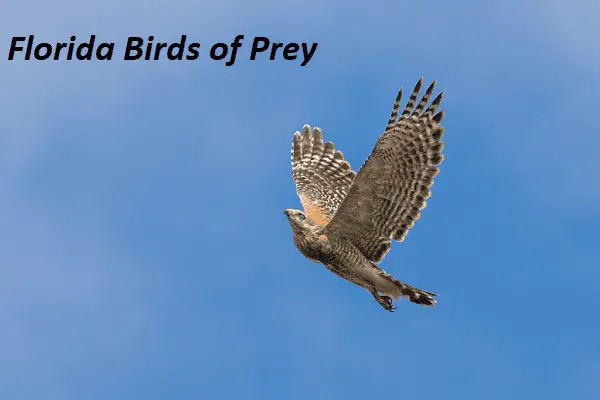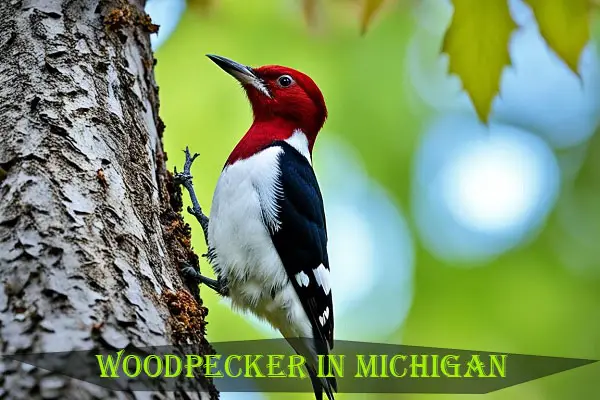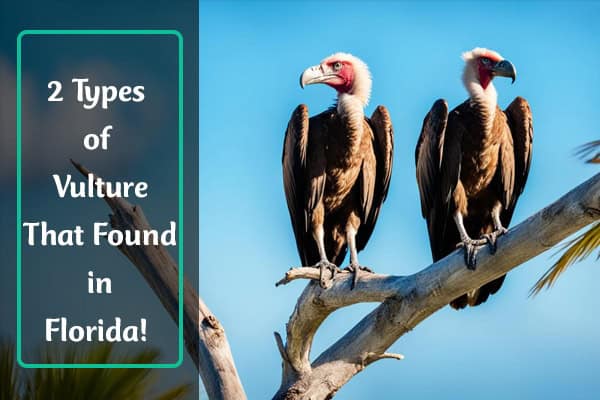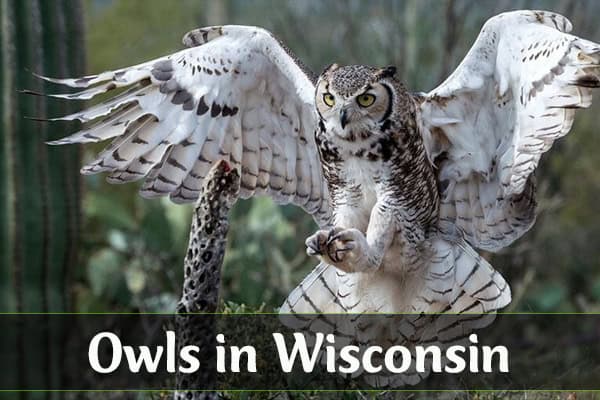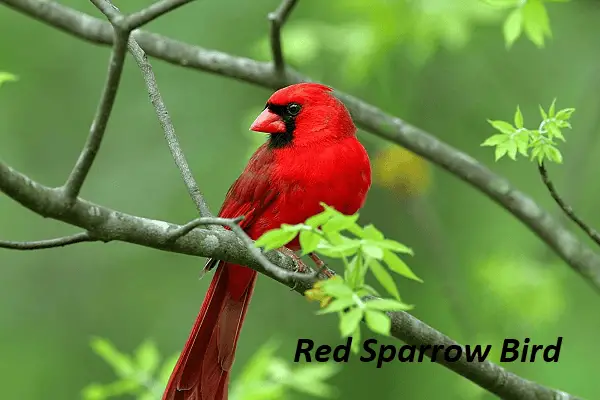11 Types Of Owls in Michigan (With Pictures)
Did you know the Great Horned Owls of michigan can live up to 28 years? This is just one amazing fact about Michigan’s owl species. We’ll explore the 11 different types of owls you might see here. Michigan’s owls delight birdwatchers, from the Great Horned Owl to the Northern Saw-Whet Owl.
We’ll share stunning pictures and interesting facts about Michigan’s owls. Whether you’re a seasoned birder or new to owling, we’re excited to share their world with you. So, grab your binoculars, and let’s explore the world of owling in Michigan!
Introduction to Owls in Michigan
Michigan is full of wildlife, with owls being a big part. The state has eleven owl species, making it great for birdwatchers. We can see seven owl species often, and five rare ones mostly in winter.
The Great Horned Owl, Barred Owl, and Eastern Screech Owl are well-known in Michigan. The Great Horned Owl can have a wingspan of up to 44 inches. Barred Owls have a wingspan of about 42 inches and live in forests.
These birds love wooded areas and open fields. They are amazing to watch.
Owls in Michigan show us how different they can be. Even though they are hard to find during the day, knowing more can help us see them. Let’s learn more about owls and why they’re important in Michigan.
Habitat and Distribution of Owls in Michigan
Michigan’s landscapes are perfect for many owl species. The forests and wetlands are key for hunting, nesting, and breeding. Owls like dense woods near wetlands for plenty of prey.
Different habitats in Michigan suit different owl species. The north’s forests are home to Great Horned and Barred Owls. Southern fields and marshes are where Short-eared Owls live, thanks to the rodents.
The Upper Peninsula is a great place for birdwatching, especially for spotting great gray owls. Places like the Whitefish Point Bird Observatory are perfect for spotting owls. These areas show how forests and open lands affect owl numbers.
| Habitat Type | Owls Found | Features |
|---|---|---|
| Forests | Great Horned Owl, Barred Owl | Dense cover, diverse prey |
| Wetlands | Barn Owl, Short-eared Owl | High rodent population, open hunting grounds |
| Grasslands | Short-eared Owl | Minimal cover, effective foraging |
| Urban Areas | Barn Owl | Nesting in man-made structures |
Understanding owl habitats helps us protect them. By studying owls in Michigan, we can improve conservation. This ensures owls thrive in our diverse ecosystems, as highlighted by Audubon Great Lakes.
Owl Types Of Michigan
Michigan is home to many owl species, exciting birdwatchers and nature fans. Our look into Michigan’s owls shows how they adapt and behave. We see owls like the Great Horned Owl, Barred Owl, and Eastern Screech Owl. Each plays a special role in our ecosystem.
Overview of Owl Species
Michigan has ten notable owl species, found all over the state. The most well-known are:
- Great Horned Owl
- Barred Owl
- Eastern Screech Owl
Owls, including the great horned and eastern screech owls, are most active at dawn and dusk. They make sounds more when the moon is bright. This makes them easier to spot, especially the barred owl, during these times.
Importance of Owls in Michigan’s Ecosystem
Owls are key predators, controlling rodent numbers. This keeps our ecosystems balanced, particularly for the owl populations in Michigan. Their presence shows the health of our environment.
Some owls, like the Boreal Owl, are hard to find. Seeing them in the wild shows why we must protect their homes. Birdwatching in Michigan lets us see these hunters’ beauty. It helps ensure they’re around for future generations.
1. Great Horned Owl
The Great Horned Owl, or Bubo virginianus, is common in North America, including Michigan. It has tufted ears and striking mottled feathers. Knowing about this owl’s identification, behavior, and habitat helps us appreciate it more.

Identification and Behavior
Great Horned Owls are big, up to two feet long and 5.5 pounds. They have big ear tufts and eyes for great night vision. Their grip is strong, 28 pounds, to catch prey bigger than them.
They can turn their heads over 180 degrees. This helps them hunt better. Their low-pitched hoots can be heard far away.
They live in many places in Michigan, including woodlands and suburbs. They eat many different animals, including birds like Ospreys and Peregrine Falcons.
Habitat and Diet
In Michigan, Great Horned Owls have a lot of places to live. They eat small mammals, birds, and reptiles. They sneak up on their prey because of their soft feathers.
| Prey Types | Description |
|---|---|
| Rodents | Commonly caught prey, providing a reliable food source. |
| Birds | This includes larger species such as ospreys and smaller birds. |
| Reptiles | Occasionally hunted for dietary variety, including frogs and scorpions. |
We must protect these amazing birds from habitat loss and pesticides. Helping the Great Horned Owl is key to keeping wildlife in Michigan safe.
2. Barn Owl
We examine the Barn Owl’s unique traits and range. This bird, known as Tyto alba, has a heart-shaped face and flies silently. Knowing about the Barn Owl is key, especially since its numbers are dropping in Michigan.
This bird used to be common in Michigan. But now, it faces big challenges to survive.
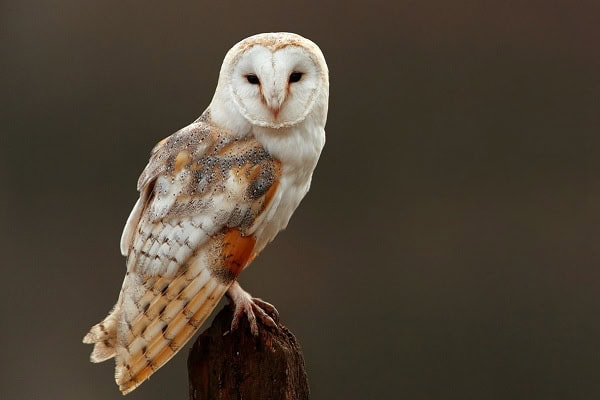
Characteristics and Range
The Barn Owl is medium-sized with long wings. It flies in a unique way, similar to the graceful movements of a hawk. It’s bigger than a screech-owl but smaller than the Great Horned Owl.
Its feathers are pale, with buff and gray on its head and back. Its face and underwings are white. In Michigan, seeing Barn Owls has become rare. The last breeding pair was seen in 1983, and the last single owl in 2000.
Barn Owls like open areas, such as grasslands and marshes, for hunting. They nest in old buildings and tree cavities, which are key to their survival.
Foraging Habits and Conservation Status
Barn Owls hunt at night, using sound to find prey like small rodents. They fly low over open land, making them good hunters. But, they face threats like losing their homes, getting hit by cars, and diseases like West Nile virus.
An injured Barn Owl in Coopersville showed signs of distress. This could be due to these threats.
Efforts are being made to save the Barn Owl. Places like Blandford Nature Center help injured owls. They give them medical care and try to get them to spot them in Michigan again. With our help, we can save this beautiful bird.
3. Long-Eared Owl
The Long-Eared Owl, known as Asio otus, is found in Michigan’s forests. It has tufted ears and striking feathers. Its face is buff or orange with black, brown, and buff patterns.
These owls live in different forests in Michigan. They like dense trees for hiding during the day. They are active at night, especially from November to February and March to June.
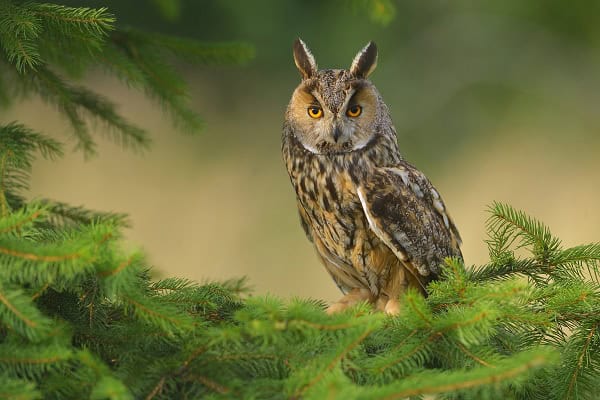
Long-eared owls make many sounds like hoots and squeals. These sounds help them find mates and mark their territory. Birdwatchers can use these sounds to find them at night.
| Characteristic | Information |
|---|---|
| Size varies among species, such as the great horned and snowy owl. | Smaller than Great Horned Owls but larger than Western screech owls |
| Distinctive Traits of various owl species enhance the joy of birding. | Buff or orange faces with patterns of black, brown, and buff feathers |
| Vocalizations | The variety includes hoots, squeals, and barks and typical vocalizations of the barred owl. |
| Roosting Behavior | Roosts in dense parts of trees, often communally in winter |
| Migration Period | The fourth week of November to the fourth week of February |
| Nesting Season | Third week of March to first week of June |
| Banding Records (2021) | 465 Long-Eared Owls caught, a record for WPBO |
Even though they are uncommon, Long-Eared Owls are important in Michigan. Learning about them helps us appreciate and protect these amazing birds.
4. Short-Eared Owl
The Short-Eared Owl (Asio flammeus) is fascinating. It has a rounded head and mottled feathers. These help it blend in well.
Learning about their nesting habits shows us their challenges, especially during the breeding season.
Appearance and Nesting
These owls have yellow eyes and soft tufts that look like ears. Similar to the great horned owl, they nest on the ground from April to July and hide their nests in tall grasses.
They lay four to seven eggs. But, their nests can be destroyed by habitat loss.
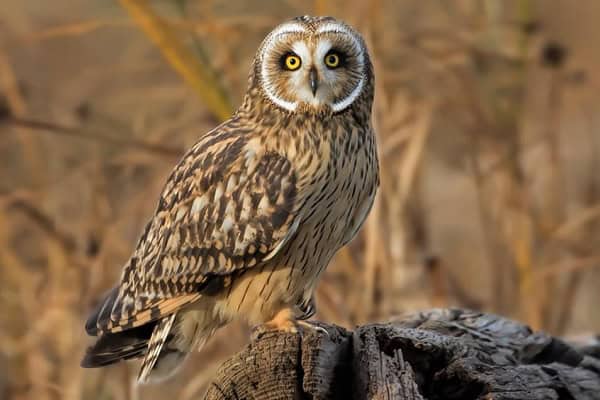
Habitat Preferences
Short-eared owls love open spaces, making them a common sight during winter birding. They need big grasslands and wetlands. These areas are over 250 acres, providing ample space for owls like the snowy owl.
Conserving these habitats is key. It helps them hunt and breed. However, their numbers are dropping fast in Michigan.
| County | Occurrences | Last Observed: A great horned owl was seen in the area. |
|---|---|---|
| Chippewa | 1 | 1984 |
| Hillsdale | 1 | 1996 |
| Missaukee | 1 | 1992 |
| Osceola | 1 | 1992 |
Knowing about their nesting and habitat needs is important for the conservation of owls in Michigan. It shows why we must protect these owls in Michigan. They need vast areas to survive.
5. Northern Saw-Whet Owl
The Northern Saw-Whet Owl, known as Aegolius acadicus, is small. It looks like a robin. It has big heads and no ear tufts.
These owls like dense forests. They hide in evergreen trees during the day. They are hard to see because they hunt at night.
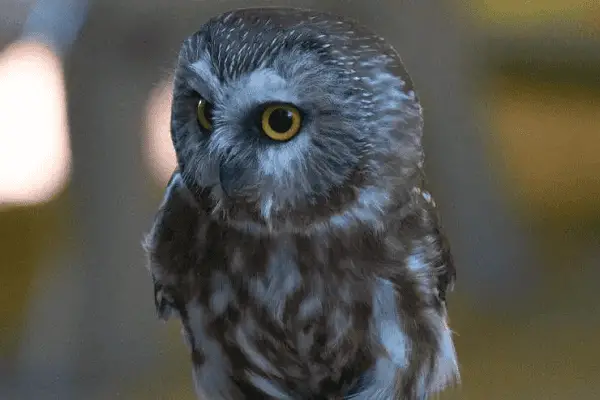
Young owls are dark brown with yellow bellies. Adults are brown with white spots and bright yellow eyes, traits often seen in common owls. Their faces are white.
They nest in tree holes or boxes, eat small mammals like deer mice, and move to warmer forests in winter.
Their calls are high-pitched and loud, making them easily identifiable during birding. They make sounds in the evenings from January to May, adding to the forest’s sounds.
Studies like Project Owlnet help us learn about them. They track and band owls every fall. These owls are interesting to both bird lovers and scientists.
6. Barred Owl
The Barred Owl, or Strix varia, is common in Michigan’s woodlands. It stands out with its striking looks and unique calls. Let’s explore what makes this owl special.
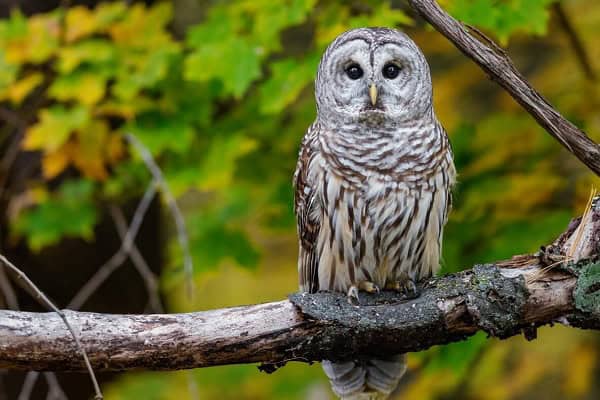
Physical Description and Vocalizations
The Barred Owl’s mottled brown and cream feathers help it hide in the forest. It’s bigger than a Barn Owl but smaller than a Great Horned Owl. Its broad wings and large head make it look blunt-headed when flying.
Barred Owls are mostly active at night but can be seen in the early morning and evening, especially in Michigan’s Eastern Upper Peninsula. Their call, “Who cooks for you? Who cooks for you-all?”, is easy to recognize. This call is a big part of their identity.
These owls live in mature forests and eat a variety of foods like amphibians, fish, and small mammals. They like areas with both deciduous and evergreen trees, near water. During the day, they rest in trees, waiting for night to hunt again.
| Attribute | Description |
|---|---|
| Size | Between a crow and a goose |
| Plumage | Mottled brown and cream colors |
| Habitat | Mature forests with a mix of tree species |
| Activity | Nocturnal, with potential morning and evening activity |
| Diet | Amphibians, fish, and small mammals |
| Notable Calls | “Who cooks for you? Who cooks for you-all?” |
7. Eastern Screech Owl
The Eastern Screech Owl, known as Megascops asio, is found in Michigan. It has gray or reddish-brown feathers with bands and spots. This makes it blend well into the woods.
It’s a bit bigger than a European Starling. This makes it interesting to see in our backyards.
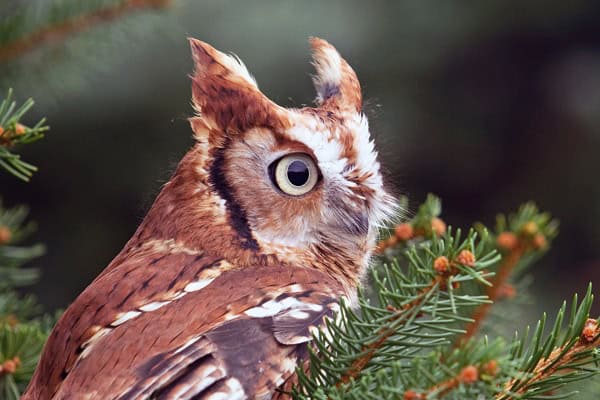
Eastern Screech Owls are mostly heard at night. They make unique calls like trills and whinnies. They live in woods and suburbs, where they can raise more young.
They nest in tree holes or boxes. They stay together for life. They lay 2 to 7 eggs from February to March. They hunt insects and small animals.
The following table summarizes key Eastern Screech Owl traits:
| Trait | Description |
|---|---|
| Size | 16 to 25 cm (6.3 to 9.8 inches) in length, typical for the eastern screech owl. |
| Weight | Average mass of 164.1 grams (5.78 ounces) |
| Color Morphs | Gray and rufous; about one-third are red |
| Habitat | Wooded areas, urban environments, and suburban neighborhoods are all habitats for the eastern screech owl. |
| Diet | Insects, small mammals, birds, amphibians, reptiles |
| Lifespan | Averages around 14 years in the wild |
| Home Range | Varies from 6 to 16 hectares |
| Breeding Season | February through March with 2 to 7 eggs typically |
The Eastern Screech Owl is a special bird. It lives in woods and suburbs, habitats favored by the eastern screech owl. It’s exciting to see common owls in our neighborhoods during birding excursions.
8. Snowy Owl
The Snowy Owl, known as Bubo scandiacus, is a bird that amazes us with its white feathers. They come to Michigan in late December and stay until March, allowing us to see their beauty up close.
In Michigan, especially in Chippewa County, we see the most Snowy Owls. Over the last seven years, they have been spotted in every county. This shows how well they adapt to different places.
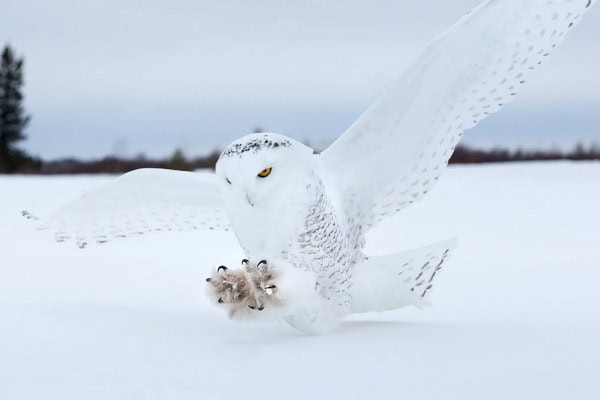
These owls are active during the day, especially at dawn and dusk. They like open places like fields and dunes, which attract various owl species. They eat small mammals, like lemmings, and can have up to 10 chicks in a nest.
Because of climate change and habitat loss, Snowy Owls are vulnerable. But, they are not considered endangered worldwide. Since 2013/2014, they have been more common in the Great Lakes, including Michigan. This shows how important it is to protect their homes for the survival of rare winter owls.
The Snowy Owl’s white feathers make Michigan’s winter even more magical. Seeing them reminds us of the beauty and complexity of birds in our state.
Read More🐦Related Articles:
Conclusion
Michigan has many owl species, like the Great Horned Owl and the Northern Saw-whet Owl. These birds enrich our nature and offer great opportunities for owling. Seeing them helps us connect with nature and understand our part in protecting it.
We work together to keep their homes safe, which helps these amazing birds live well for many years. We also keep Michigan’s nature in balance by fixing habitats and teaching others about the great horned owl.
Our journey with Michigan’s owls shows us that we must keep learning and acting. We hope to see more of these birds and share our love for them. Together, we can ensure that they have a good home.
Frequently Asked Questions
Q1. What is the most common owl in Michigan?
The Eastern Screech-Owl is the most common owl in Michigan.
Q2. How do you see owls in Michigan?
To see owls in Michigan, visit wooded areas at dawn or dusk, listen for their calls, and look for them perched in trees, especially during fall and winter.
Q3. Are owls endangered in Michigan?
Most owls in Michigan are not endangered, but some species, like the Northern Spotted Owl, face habitat loss concerns.
Q4. Are there Barred Owls in Michigan?
Yes, Barred Owls are found in Michigan, typically in mature forests near water.


